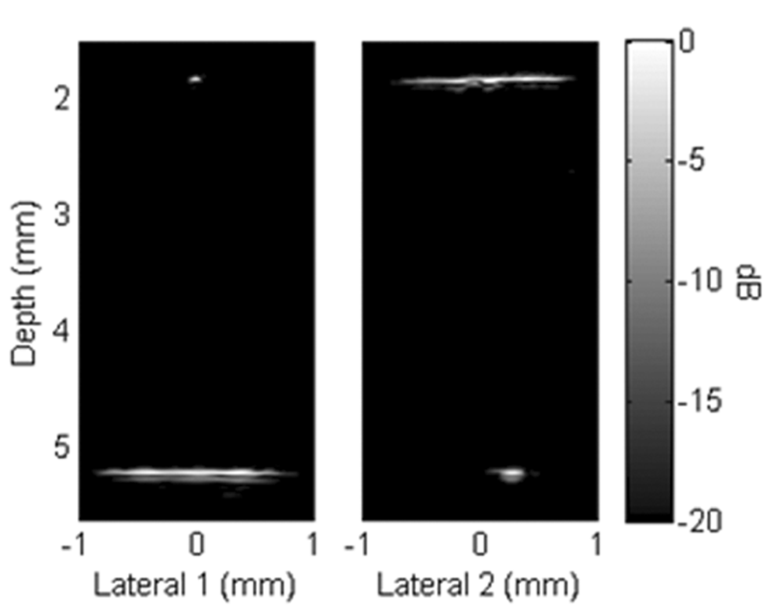Project goal: Develop compact probes for high-resolution intravascular ultrasound (IVUS) imaging
Devices that optically generate and detect ultrasound circumvent problems intrinsic to small-scale piezoelectric transducers (crosstalk, RF interference, small capacitance, etc.) by requiring no electrical cabling or interconnections. Thin-film etalons with compressible cavities are good candidates for optical ultrasound sensor arrays and have been shown to exhibit the high sensitivity and large bandwidth ( > 30 MHz) required for high-resolution imaging (Fig. 1). High frequency ultrasound can also be generated via the photoacoustic effect – the conversion of optical energy into a thermoelastic wave. In this way photoabsorptive thin films can be used as targets for use in pulse-echo mode. Moreover, the simple nature of these films allows them to be integrated into etalon structures so as to provide an all-optical transmit/receive ultrasound device. Because the acoustic transduction mechanisms rely primarily on light delivery, the coupling of a 2-D array of these transducers with optical fibers would provide a compact and flexible device well suited for endoscopic and intravascular ultrasound.
An ideal transmitting film would be one that is (1) easy to fabricate with small thickness, (2) highly photoabsorptive in a narrow spectrum, and (3) sufficiently transparent to wavelengths used for etalon operation. We have achieved these aims using polyimide PI-2555 (HD Microsystems) – a material known for its resistance to high temperatures and characteristic optical absorption in the UV spectrum. In our work we have deposited a polyimide film in between a Au/SU-8/Au etalon and its glass substrate to create an all-optical device (Fig 1). Figure 2 demonstrates the transmit/receive response of the transducer when irradiated with a UV pulse and the detection of the pulse-echo using the etalon structure. Also shown is the imaging of two 80 micron wires using a 2 mm x 2 mm synthetic array (Fig. 3).

Fig. 1. (top) Illustration of all-optical transducer. High-frequency ultrasound (HFUS) is generated in a 2.5 micron polyimide (PI) thin film using a 5 ns UV pulse. The echo is detected using a 10 micron etalon operating in the near-infrared (NIR) spectrum. (bottom) Etalon transduction mechanism. Pressure from acoustic waves modifies the cavity thickness,  . When the reflected intensity of the NIR beam is monitored, shifts in resonance wavelength occur due to an alteration in thickness,
. When the reflected intensity of the NIR beam is monitored, shifts in resonance wavelength occur due to an alteration in thickness,  . If the input beam is programmed at a fixed wavelength,
. If the input beam is programmed at a fixed wavelength,  , which happens to fall on a falling or rising edge of the resonance curve, a change in reflected intensity,
, which happens to fall on a falling or rising edge of the resonance curve, a change in reflected intensity, , is observed due to this shift (Sheaff, 2010).
, is observed due to this shift (Sheaff, 2010).

Fig. 2. Etalon detection of polyimide pulse-echo; (a) heat signal generated by UV pulse with no target present; (b) pulse-echo off of glass-slide high-pass filtered at 4MHz; (c) power spectrum of pulse-echo (Sheaff, 2012).

Fig. 3. Reconstruction of two 80 micron wires positioned perpendicular with respect to one another (Sheaff, 2012).